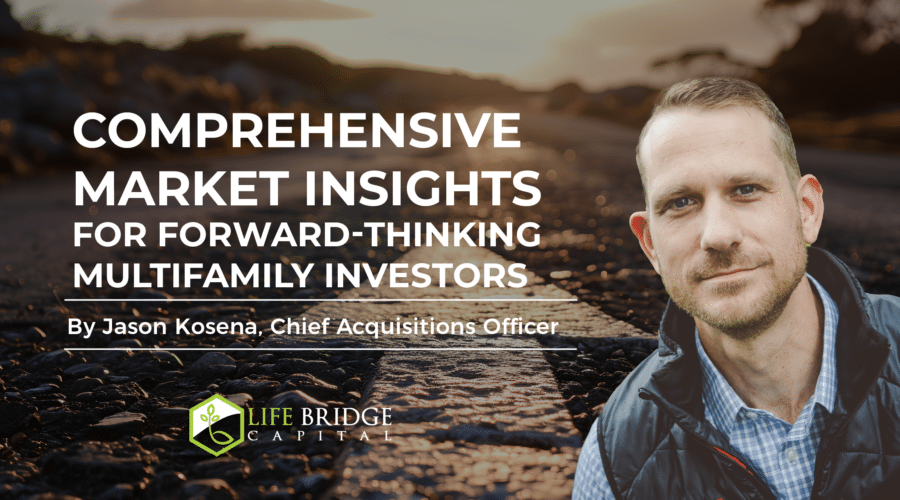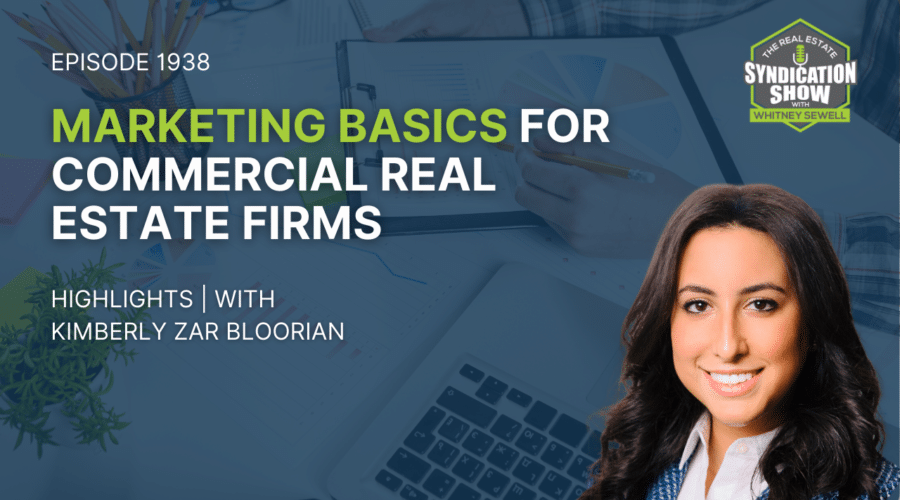Upon finding the right piece of real estate, securing financial backing stands as a major hurdle between the would-be owner and dreams of passive income and property appreciation. Commercial real estate loans fill that gap. Read on to understand the ins and outs of obtaining and using these loans.
Life Bridge Capital is a leading real estate syndication company. We offer our investment partners the opportunity to leverage shares of multifamily rental properties into a passive monthly income. Learn More
What Are Commercial Real Estate Loans?
Commercial real estate (CRE) loans finance the purchase or renovation of non-residential income-producing properties. These include spaces like retail shops, hotels, offices, and medical offices.
The property itself serves as security for the loan, just as residential mortgages are attached to homes. While there are many similarities between commercial and residential loans, commercial loans offer some much-needed options for business owners.
Shorter Repayment Schedules
Borrowers most familiar with the traditional 30-year fixed-rate residential mortgage may be surprised by the variety of payment options available to commercial loan borrowers. The repayment timeline is usually shorter, between 5 to 20 years, but this does not always translate to higher monthly payments.
One typical schedule features a balloon payment. Monthly payments are made for several years, often 5 to 10. During this time, the payments are amortized on a 30-year payout schedule, meaning the monthly payments are low as if the loan is being paid over 30 years. Then, at the end of the 5 to 10-year payment term, the borrower pays the remainder due in a large, lump-sum payment called a balloon payment.
Longer payment schedules generally come with higher interest rates, so borrowers should carefully consider which payment terms best suit the business.
Entities, Not Individuals, Receive the Loan
Whereas individual buyers typically apply for residential loans, commercial loans go to the company, partnership, or trust investing in the property. The individuals behind those entities may still be personally responsible for ensuring the loan is paid.
CRE loans that only rely on the property itself as collateral are called non-recourse loans. The lender does not pursue the individuals behind the business or company for any remainder of the loan.
More often, commercial loans are recourse loans that permit the lender to collect from the individuals that comprise the entity in the case of default. Recourse loans protect lenders and give them security when making loans to companies and other entities without a credit rating or score.
Commercial Real Estate Loan Fees and Penalties
CREs come with their own set of fees and penalties that cost the borrower money. When shopping for lenders, carefully research these items to determine the overall cost of the loan.
In particular, pay attention to prepayment penalties. These often apply in commercial ventures when the property is sold, hopefully for a great price, earlier than expected. Then, when paying off the loan, the lender may charge a prepayment penalty that is a percentage of the extra amount paid.
Additionally, some lenders work interest guarantees into the loan agreement, meaning the borrower has to pay a set amount of interest—often five years’ worth, if the loan is paid off early. Other loans simply do not allow early payoff, so protect yourself by carefully reading the terms before signing.
Commercial loans can be riddled with fees that include one percent origination fees and even annual fees totaling a small percentage of the loan each year.
Where to Get a Commercial Real Estate Loan
Borrowers have many options beyond a traditional brick-and-mortar bank. Each loan type has its own restrictions, so carefully research each one to find the best fit for your property.
Traditional Banks
Banks can be a good fit for borrowers looking for longer-term loans. More time to pay back the loan and competitive rates continue to draw people, as does the comfort of familiar big-bank names. Unfortunately, banks maintain their lower rates and favorable terms by being very selective when choosing borrowers. They are likely to have the most stringent requirements and take the most time to complete the underwriting process.
Commercial Lenders
To get a loan more quickly or with a less robust financial position, turn to a commercial lender. Their loan products are available to a broader audience with less challenging underwriting standards and often have a speedier turnaround.
The upshot to that extra convenience is usually higher rates. Commercial lending loans frequently come with shorter repayment periods, often only 5 to 10 years. Consequently, a large balloon payment may be required at the end of the payoff period.
Hard-Money Lenders
For even less stringent requirements and quicker turnaround, consider hard-money lenders. These are private lenders that offer short-term loans based on the property’s value. Hard-money loans rely on the merits of the property rather than the credit history of the business or owners, so expect more onerous loan-to-value requirements, meaning bigger down payments.
Crowdfunding
A modern take on commercial real estate loans comes in the form of crowdfunding, also called peer-to-peer (P2P) marketplaces. Real estate crowdfunding provides loans for real estate endeavors. While the borrower receives one loan, the funding for that loan comes from many investors, who each contribute a small portion.
The platforms rely on accessible applications and quick funding periods to lure borrowers, and in return, borrowers can expect to pay interest rates on the higher end. P2P loans usually have additional origination fees, but they are available to most borrowers, even those with lower credit scores.
Small Business Administration-Guaranteed Loans
Finally, the most appealing real estate loan option for many small business owners is a loan through the Small Business Administration (SBA). The SBA is a cabinet-level federal agency that focuses on advancing small businesses in the United States. Some of the agency’s most important work involves agency-guaranteed loans.
Rather than lending the money itself, the SBA guarantees loans made to borrowers from outside lenders, meaning the SBA compensates the lender for a portion of the loan if the borrower defaults.
Agency-backed loans make borrowers very appealing to lenders because lenders experience exponentially less risk under the agency guarantee infrastructure. Consequently, that guarantee gives borrowers more buying power in the form of long-term, fully amortized loans at competitive rates.
SBA loans are desirable, but they can be hard to get. All SBA-guaranteed loans require that existing buildings be 51 percent owner-occupied, and new construction buildings must be at least 60 percent owner-occupied. Then, each of the seven types of SBA loans has specific caps, requirements, and terms. The two most popular products are the 7(a) and 504 loan programs:
SBA 7(a) Loans
The 7(a) loan is the agency’s most sought-after loan product, in part due to its guarantee of up to 85 percent of the loan for loans less than $150,000. With so much of the loan guaranteed by a government agency, it opens many doors for the borrowers. For larger loans, which can range up to $5 million, the agency can guarantee up to 75 percent of the loan. Even better, the loans can be structured with up to a 25-year payout.
These loans do come with a slow processing period and require decent credit and sufficient net operating income to demonstrate likely repayment.
SBA 504 Loans
SBA 504 program loans are another popular real estate financing option with maximum loan amounts of $5.5 million. Like the 7(a) loans, the processing time is slow, and good credit and a demonstrated ability to repay the loan are necessary.
These loans attract borrowers through rates that are often less than the current market rate or that of 7(a) loans. The 504 loans can also be long-term, up to 25 years, and can be fully amortized to avoid final balloon payments.
Funds from 504 loans can go toward new construction, purchasing existing buildings, long-term equipment purchase, building improvements, and infrastructures like streets and utilities.
Qualifying for a Commercial Real Estate Loan
Commercial real estate loan borrowers should prepare for the same level of financial scrutiny as they would for a residential loan. Unfortunately, business finances are often much more complex than a simple bank account statement.
Lenders try to minimize their risk by analyzing a business’s credit score, finances, and sometimes even the owner’s credit history. This is because many small businesses fail to succeed, and the lenders want to be sure they do not end up on the losing end of the bargain.
During the underwriting process, expect to submit profit and loss statements as well as other records as requested by the processor.
Credit Score
Lenders can obtain the business’s credit score through the FICO Small Business Scoring Service. However, for newly formed companies that lack a credit score, the lender has to rely more heavily on the owners’ credit history to determine creditworthiness.
Net Operating Income and Debt-Service Coverage Ratio
Before funding the loan, lenders also want to be assured of the company’s future creditworthiness. To do this, they carefully examine the business’s finances. One of the most important statistics considered is the net operating income (NOI).
The NOI reflects a business’s annual income from all sources after annual expenses are deducted. It does not include capital expenditures, income tax, or principle or interest payments on any business debt.
Lenders use the NOI and annual mortgage principle and interest payments, called the debt service, to determine the maximum loan amount. Divide NOI by the annual debt service amount to find the debt-service coverage ratio (DSCR). For example, a property with an annual NOI of $100,000 and debt-service of $75,000 has a DSCR of 1.3 ($100,000 ÷ $75,000 = 1.33).
Ideally, businesses should aim for a DSCR of at least 1.25 to demonstrate sufficient cash flow to pay off the loan. Lower DSCRs may still qualify for financing but are associated with higher rates and overall less favorable terms. Likewise, lenders may require that higher-risk businesses have a higher DSCR.
Final Thoughts
Those purchasing commercial real estate will find many lenders and types of loans. To maximize profit, carefully research the available options, and if possible, improve the NOI well in advance.
Life Bridge Capital is a leading real estate syndication company. We offer our investment partners the opportunity to leverage shares of multifamily rental properties into a passive monthly income. Learn More



